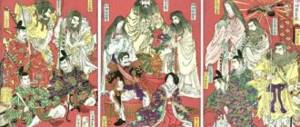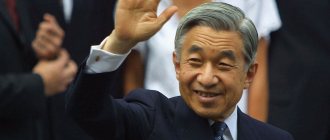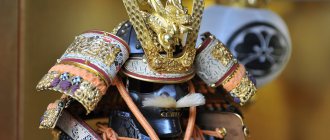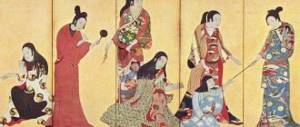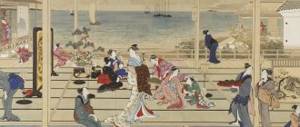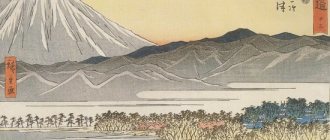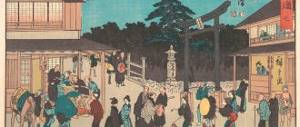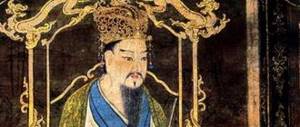World War I and the era of change in Japanese politics
A hundred years ago, in July 1914, a great war broke out in Europe, and in August Japan entered it on the side of the Allies, declaring war on Germany. This was a period of change in Japanese politics. After the overthrow of the Tokugawa shogunate in 1867, Japan set out to create a modern state; the Constitution of the Empire of Japan was adopted in 1889, and a parliament was formed in 1890. About a quarter of a century after this, the First World War began. At first, the implementation of the Meiji reforms was led by hambatsu
- came from the samurai class, mainly from the Satsuma and Choshu regions.
They were opposed by political parties that became the leading force after the events of the Sino-Japanese and Japanese-Russian wars, and among them a particularly prominent role was played by the Society of Friends of Constitutional Government ( Rikken Seiyukai
), founded by Ito Hirobumi in 1900.
The beginning of the 20th century became a new period of Japanese politics in two senses. Firstly, the old generation of politicians was replaced by a new one, and secondly, the political system, in which the genro
(politicians representing the samurai bureaucracy
of hambatsu
) became more open.
In 1901-1913, two politicians of the new generation fought for power - Katsura Taro, who represented the hambatsu
, and Saionji Kimmochi, who headed the Seiyukai after Ito Hirobumi.
However, this transition period could not continue indefinitely. The year 1912, the first year of the Taisho era, was a turning point for Japanese politics. The second Saionji cabinet resigned in response to demands from the Minister of the Army to increase the army by two divisions, and this marked the beginning of the first movement in defense of constitutional government under the slogans of removing hambatsu
.
According to the Meiji Constitution, the appointment of a prime minister is the exclusive right of the emperor, and the candidate for this position was determined at meetings of the genro
, but now they are talking about the fact that the constitutional way of government is that the party that receives the majority must nominate a candidate for prime minister in the House of Representatives.
Under such public pressure, Katsura Taro, who formed the next cabinet, resigned in early 1913, just over fifty days after taking office. This event was called the "political crisis of the Taisho years" ( Taisho seihen
).
And at the beginning of 1914, a new crisis occurred related to a corruption scandal in which the leadership of the navy was involved.
Peculiarities
The Taisho era is associated with the reign of the Japanese Emperor Taisho. The Japanese system of periodization of history [ja] (before the introduction of the system, one monarch - one motto of government) assumed that historical periods correspond to the name of the locality in which the government was located at that time, i.e. The classical periodization of Japanese history is associated with the location of the capital: Asuka, Nara, Heian, Kamakura, Muromachi, Edo. The Taisho era covers a period in history from 1912 to 1926 lasting 14 years, thereby being the shortest period in the Japanese historical system of periodization.
The shortest periods of Japanese history after the Taisho era are the Heisei era (1989 - 2019), which lasted 31 years, and the Azuchi-Momoyama period (1573 - 1603), which lasted 30 years.
1912, i.e. The 45th year of the Meiji era or the zero year of the Taisho era coincides with the beginning of the Xinhai Revolution in China, i.e. with the beginning of the early Republican era in China. Also, the beginning of the Taisho era coincides with the birth of the founder of North Korean statehood and ideology, Kim Il Sung, i.e. with the beginning of the Juche calendar.
The Taisho era is associated with the beginning of mass movements in defense of the constitution [ja] (Japanese goken undo) in 1912 and 1924, directed against the oligarchic clans in the government. The activities of activists of the first wave of the movement led to the dismantling of the political system based on the power of a cabinet of ministers closed from external influence, and the beginning of the growth of the influence of political parties. These political and social changes went down in history as the Taisho democracy. Among the initiators and leaders of the new order, the most famous political figures are Yukio Ozaki and Tsuyoshi Inukai.
Typically, the period of Taisho democracy is divided into two parts - before and after the rice riots of 1918 (7th year of Taisho). This is due to the fact that in the same year, after the end of the rice riots, the Japanese politician Hara Takashi, who did not belong to the aristocratic class, but was a representative of the “heimin” class, was appointed prime minister. “common people”, which is why his unofficial nickname was “heimin saisho”, i.e. "prime commoner." For the first time in the political history of Japan, Hara Takashi formed a functioning “party” government (Hara cabinet).
Hara Takashi is known as an outstanding politician with excellent leadership qualities, who implemented the 4 main strategies of his cabinet: “reform of the educational system”, “improving the logistics infrastructure”, “stimulating trade and industrial development”, “strengthening national defense”, but he opposed the adoption of the law on universal suffrage[ja], although his party had a parliamentary majority, which caused sharp criticism in society among liberals and socialists. Electoral reform was never carried out by the Hara cabinet, since in 1921 (10th year of Taisho), Hara Takashi was assassinated[ja] at Tokyo Station by terrorist Nakaoka Kon'ichi[ja].
After the assassination of Hara Takashi, the activity of the Japanese movement for universal suffrage increases, as well as the movement for women's suffrage, the ideological leaders of which were the pioneers of Japanese feminist ideology - Hiratsuka Raicho[en] and Ichikawa Fusae[en].
In 1925 (the 14th year of Taisho), the cabinet of Kato Takaaki passed a law on universal suffrage, but at the same time, Japanese domestic political life was strongly influenced by the revolution in Russia, which led to the growth of socialist and communist sentiments in society. In order to counter the further spread of these ideas, a repressive law “On Maintaining State Security” was adopted. At the same time, there was an intensification of socio-political thought in an attempt to find a compromise between monarchical and democratic ideas, which led to the formation of the concept according to which the emperor was a kind of state political body along with parliament. This concept was developed by the Japanese political scientist and specialist in the field of constitutional law Tatsukichi Minobe[en], who attempted to rethink and interpret constitutional laws, the purpose of which was also to ideologically ensure state control over society. Along with the ideas of Tatsukichi Minobe, the socio-political thought of that time was strongly influenced by another Japanese political scientist and historian Sakuzo Yoshino[en], who put forward the concept of “Minponshugi[ja]”, i.e. “power of the people,” which tried to integrate monarchical institutions into a democratic society.
On October 25, 1921 (10th year of Taisho), Crown Prince Hirohito was officially appointed regent due to the sharp deterioration of Emperor Taisho's health. At the same time, the largest Shinto shrine in the capital, Meiji, was built, dedicated to the late Emperor Meiji and his wife Shoken.
In 1923 (the 12th year of Taisho), 8 days after Prime Minister Katō Tomosaburō died, the Great Kanto Earthquake occurred, causing devastating damage to the Tokyo metropolis, shortly after which large-scale reconstruction efforts began. They were headed by a new cabinet under the leadership of Yamamoto Gombei, who had previously served as prime minister in 1913.
However, a few months later, Gombei resigned as prime minister, after which a new government of three constitutional defense parties was formed, headed by Prime Minister Kato Takaaki, who was a member of the second wave of the constitutional defense movement. After the end of the First World War, the so-called "Shidehara Policy[ja]", the purpose of which was to adapt the country's foreign policy to the new world system of the Versailles agreements. This course was carried out by the Minister of Foreign Affairs Shidehara Kijuro (cabinet of Kato Takaaki), which also consisted of a policy of non-interference in the internal affairs of the Republic of China, the establishment of diplomatic relations with the USSR, etc. In general, it could be characterized as a pacifist foreign policy course, focused on the search for international compromises.
A feature of the Taisho era is also the changes that took place in the political world of the country, due to the fact that at that time, for natural reasons, eminent politicians who were born in the Edo era and who led the country began to retire due to age or poor health, or simply die the entire previous period. These politicians formed the core of the so-called. “Meiji oligarchy[en]” or “hambatsu” (Japanese: 藩閥). A new generation of politicians began to take their place, educated and trained in new state educational institutions, which could be entered only after passing serious entrance exams.
The Taisho period coincides with many world events of historical significance. One of the results of the First World War was a wave of anti-monarchist revolutions. First of all, this affected the countries that lost the war (the so-called Central Powers), which included Germany, Austria, the Ottoman Empire, as well as the Russian Empire that concluded a separate peace agreement with Germany and the Russian Empire that emerged from the war. The USSR became the first country to abandon capitalist values, proclaiming socialist and communist ideals of society, while the royal family from the Romanov dynasty was executed. In Germany, after the adoption of the Weimar Constitution, a republic was established, operating on the principles of parliamentary democracy and federalism.
In connection with world events, the Japanese government feared the spread of communist and socialist ideas in society, which could lead to an intensification of the labor movement and the elimination of imperial power. In connection with this, a series of legislative acts, the so-called, were adopted. laws to maintain public safety, the main purpose of which was to suppress dissent in society. However, with the beginning of the revolution in Russia, communist ideas began to actively spread among the Japanese intelligentsia. Japanese intellectuals put forward demands for speedy reforms and renewal of the political system, and the most radical of them called for revolution. In general, it can be said that in the world of political movements during the Taisho democratic period, there was a tendency towards the growing influence of socialist and communist ideas.
One of the distinctive features of the Showa era is the flourishing of urban and popular culture, which was associated with the development of modern cities and economic growth. The period of rich and luxurious life of those years entered the Japanese language as “Modern Taisho”. The number of working women increased, but this did not apply to workers employed in factory and manufacturing production, but to office workers and telephone operators. In addition, attracting women to new job positions for this era in shopping centers, European-style cafes, and as conductors and train conductors was gaining popularity; film actresses appeared for the first time. One of the brightest symbols of the era was the so-called subculture. “modern girls” (“moga” is an abbreviation for Japanese: モダンガール), who wore unusual short men’s hairstyles and preferred to dress in European-cut dresses.
At the same time, during the years of the Taisho motto, the reverse side of the beginning of the heyday of entertainment urban culture was the emergence and expansion of slums, the increase in the number of spontaneous street protests, the formation of trade unions of workers and small landowners, and the intensification of strikes and protests by workers caused by worsening social contradictions.
Hara Takashi and the first party cabinet
Prime Minister Hara Takashi (Photo by Jiji Press)
The First World War, which began at this time, on the one hand, contributed to the development of the party political system, and on the other hand, it slowed it down for some time. In the 2nd cabinet of Okuma Shigenobu, who was in power at the time of entry into the war, the Minister of Foreign Affairs was Kato Takaaki, who headed the “Constitutional Association of Like-Minded People” ( Rikken doshikai
) - a party founded by Katsura Taro and opposed to the Seiyukai.
He tried to exclude genro
from the decision-making process, but was criticized both domestically and internationally for his haste in Japan's entry into the war and the "Twenty-One Demands" made to China. During the war, the disagreements subsided, the army man Terauchi Masatake became prime minister, and everything became as before, as if the first movement in defense of constitutional government had never happened. However, Terauchi’s cabinet began to be criticized for being “unconstitutional,” and in order to strengthen the political system, the heads of political parties began to be allowed directly into the decision-making process in the temporary advisory council on foreign policy issues. The end of the war was marked by economic instability, rice riots, and the rise of various labor movements, and eventually Hara Takashi, head of the Seiyukai and the first prime minister who was a member of the House of Representatives, was appointed prime minister.
The cabinet of Hara Takashi is considered the first truly party government, and it can be said that it corresponded to the spirit of the victory of democracy that reigned in the post-war world after the revolution in Russia and the entry of the United States into the war. Saionji and Makino Nobuaki, who came from a diplomatic background, were sent to the Paris Peace Conference, where on behalf of Japan they proposed to include an article abolishing racial discrimination in the charter of the future union of states. These plans were not allowed to come true, but despite this, in the hope that amendments could be made later, Japan began to participate in the planning of the League of Nations as a permanent member state.
The post-war desire for peace took different forms in Japan. In January 1920, Emperor Taisho issued the “Rescript for the Restoration of Peace,” in which he called on citizens to enjoy “the fruits of peace and alliance” “in accordance with the spirit of modern development,” and at the Washington Conference, which was held from November 1921 to February 1922 ., Japan agreed with England and the United States on cooperation in reducing naval armaments. The cause of international cooperation was facilitated not only by the party system, but also by the enlightened members of the imperial house, with broad knowledge of the international situation, with whom Hara collaborated. Crown Prince Hirohito (who later became the Showa Emperor) visited Europe from March to September 1921, where he became familiar with the consequences of the war. Subsequently, until the mid-1930s, Saionji and Makino supported him with advice.
Download the large encyclopedia of Japan from A to Z with multimedia:
TAISHO is a historical period from 1912 to 1926, named after the posthumous name of Emperor Yoshihito of Japan.
The decline in interest in Chinese events was a temporary phenomenon in Tokyo. Already in 1913, using the so-called. With the Nanjing incident (when three Japanese citizens were injured during the civil war in Nanjing), the Japanese government demanded that the Chinese authorities compensate the victims, punish the perpetrators and make an official apology.
Japanese warships sailed up the Yangtze River all the way to Nanjing (which was part of England's sphere of influence) and, at gunpoint, extracted from the Chinese not only an apology, but also new concessions in Southern Manchuria and Inner Mongolia. This led to a new outbreak of discontent with Japanese policy in Washington and London.
The outbreak of the First World War in Europe gave rise to many doubts among Japanese politicians: which of the warring coalitions should they join? The strained relations with America, England and partly with Russia were clearly pushing the Land of the Rising Sun into the camp of opponents of the Entente. Taking advantage of the tied hands of the great powers on the European battlefields, the Japanese could try to push competitors out of China and establish their complete dominance there. But no less tempting was the idea of seizing German colonial possessions in Asia. Official propaganda immediately found convincing arguments in favor of such a decision. In Tokyo they began to refer to loyalty to the spirit of the Japanese-British alliance. The Japanese man in the street was reminded of an old grievance when, after the victorious Sino-Japanese War of 1894–1895. Russia, France and Germany forced Japan to withdraw from the Liaodong Peninsula it had captured.
On August 15, 1914, Japan sent an ultimatum to the German government demanding the withdrawal of German warships from Chinese waters and the transfer to Japan, without any conditions or compensation, of the Jiaozhou territory leased by Germany “for subsequent transfer to China.” At the same time, Tokyo tried to assure the Americans and British that this gesture did not hide a desire to expand its colonial possessions in China.
On August 8, Japanese warships appeared in Chinese waters near Shandong, and on the day war was declared on Germany, August 23, they began shelling the Qingdao fortress. Then a landing force was landed on the shore. The Chinese begged the Japanese government not to violate their neutrality and not to transfer hostilities to Chinese territory. But Japan, “fighting for Chinese interests,” was adamant. The Japanese forces surrounded Qingdao with deep envelopments, and the fortress fell on November 7. But the Japanese did not stop there and captured almost the entire Shandong province, as well as German possessions on the Pacific Islands - the Marshall, Caroline and Mariana Islands.
By the end of 1914, Japan's military operations against Germany were completed, and the Chinese government demanded that the Japanese withdraw their troops from Shandong and return the port of Qingdao to China. “Offended by such brazen behavior of China,” Japan presented its ultimatum to the Chinese government. China faces the danger of repeating the history of neighboring Korea, which was forcibly included in the Japanese Empire. But this was only a prologue to even larger-scale Japanese colonial conquests in Asia.
In May 1915, by forcing China to accept the ultimatum “21 demands,” Japan actually seized a dominant position in this huge country. This could not but lead to aggravation of relations between the imperialist powers. The USA, England, and Russia greeted the strengthening of the competitor with caution. However, not everyone had the opportunity to react adequately. The Russian army fought heavy battles on the Western Front, and the tsarist government could not allocate any serious forces to strengthen its positions in Northern Manchuria. England, not wanting to aggravate its relations with its Far Eastern ally, limited itself to a discreet reminder of the need to preserve the privileges of its subjects in China. Perhaps only the United States, which by that time had not yet gotten bogged down in a world war, allowed itself to speak with official Tokyo in a raised voice. US Secretary of State Brian, immediately after reading the Japanese ultimatum to China, handed the Japanese ambassador a note objecting to granting Japan additional economic privileges and inviting Japanese advisers to central Chinese institutions. Moreover, Washington made an attempt, although unsuccessful, to persuade Russia, England and France to take joint action in this direction. And when this idea fell through, the American government sent identical notes to Tokyo and Beijing, emphasizing that the United States does not recognize any Japanese-Chinese agreements that violate the “open door” policy (i.e., the rights of American citizens in China).
Japan, which was experiencing euphoria from the success of its expansion into the continent, reacted violently to even such weak attempts to limit its influence in China. There were calls in Tokyo to “draw the sword.” In any case, dissatisfaction with the actions of the Western powers there was growing. Pro-German sentiments intensified in the country. Trade ties with German and Austrian partners were maintained almost in full. Japan responded with a categorical refusal to requests from the Entente countries to send Japanese troops to the European front against Germany. Then the British resorted to forceful pressure, limiting and in some places completely cutting off the import of a number of goods from Japan. Thus, in 1916, Great Britain introduced a ban on the import of silk, lacquer and glass products. The Japanese considered this a violation of allied obligations; rallies and demonstrations were held in Tokyo and other major cities of the country. The British government was forced to somewhat reduce customs barriers. In turn, the Japanese had to limit the commercial activity of German and Austria-Hungarian citizens on the islands. At the end of 1916, the German-Asiatic Bank was closed.
The grueling diplomatic war between the Entente countries and Japan continued. England, France and Russia insisted that China join them in military action against the Austro-German coalition. Japan, on the contrary, was interested in China taking the side of Germany. This would allow Japan to legally attack “hostile” China and occupy its territory.
To weaken the political pressure of the combined forces of the Entente countries, Japan tried to split the coalition. Tokyo began to force the conclusion of a Russian-Japanese alliance treaty, which could be contrasted with the noticeably complicated relations with England and the United States. St. Petersburg came up with a draft of such an agreement back in August 1914. But the Japanese began to explore this possibility only a year later, when its allied relations with England reached a dead end. After a short mutual sounding, on July 3, 1916, an alliance treaty was signed. As was customary then, it consisted of a public and a secret part. The public articles recorded mutual respect for the interests of the parties in the Far East and a willingness to consult if any danger arose. And in the secret part, Russian and Japanese diplomats expressed the desire that “China should not fall under the rule of any third power hostile to Russia and Japan,” while promising each other military assistance. For belligerent Russia, such an agreement was associated not only with hopes for the supply of Japanese weapons, but also with guarantees of calm on its Far Eastern borders while all its forces were tied up in the West. The agreement with Russia gave Japan the opportunity to take a tougher position in negotiations with London and Washington.
In January 1917, the Japanese government raised the question of recognizing Japan's claims to German possessions in China and the Pacific Ocean north of the equator. (South of the equator was the zone of British interests.) London, and then Paris and St. Petersburg agreed, although this was conditional on China joining the military actions of the Entente countries against Germany. Japan was forced to do this, and in August 1917 China declared war on Germany and Austria-Hungary. However, by this time Japanese positions in China were already quite strong.
Japan also wanted recognition of its privileges in China from the United States. In September 1917, Japanese Foreign Minister Ishii Kikujiro visited America. In his numerous conversations with US Secretary of State Robert Lansing, he insisted on recognizing the special position of Japan in China, similar to the special position of the United States in Central and South America. The Americans demanded that the principle of “open doors” be maintained in China. As a result, the Lansing-Ishii Agreement was signed on November 2, satisfying the interests of both parties. The United States recognized Japan's “special interests” in China due to its territorial proximity to it, without, however, indicating which areas of China could be considered particularly close to Japan. At the same time, the mention of Shandong Province, so desirable for the Japanese, was not included in the text of the agreement. The signatures of both diplomats confirmed the vitality of the “open door” and “equal opportunities” policy. The agreement was very controversial and allowed each of the parties to interpret it in their own way. However, as history has shown, if necessary, Tokyo and Washington could recall this agreement, for example, when determining the commonality of their positions regarding aggression in the Russian Far East.
At the end of 1917, Japan turned to the Entente countries with a proposal to send Japanese troops to Siberia “to protect the interests of the powers.” On January 12, 1918, the Japanese battleship Iwami appeared in the Vladivostok roadstead. On April 5, a Japanese military force landed in Vladivostok. Thus began the Japanese military intervention in the Far East of Soviet Russia.
In August 1918, the “rice riots” began in Japan; they affected about 500 cities and villages in 42 prefectures. More than 1 million people took part in them. By October, the riots were brutally suppressed by troops and police.
By the beginning of October 1918, the number of Japanese troops in the Russian Far East reached 70 thousand people.
In April 1920, under the pretext of “paying for the blood” of Japanese soldiers who died during the intervention, Japanese troops were sent to Northern Sakhalin. All Russian geographical names were immediately replaced with Japanese ones.
But the Japanese troops failed to stay in Transbaikalia. The occupied zone of the Far East continued to shrink steadily. In October 1920, the Japanese left Khabarovsk. Japan was forced to enter into peace negotiations with the government of the Far Eastern Republic.
On August 15, 1922, the Japanese military command announced the upcoming evacuation from Primorye.
In September 1922, a new peace conference was opened in Changchun, China, designed to regulate relations between the Far Eastern Republic and Japan. After three weeks of fruitless debate, no definite decision was made.
In October, the People's Revolutionary Army of the Far Eastern Republic, having stormed the fortifications of Spassk, approached Vladivostok. The Japanese command announced the withdrawal of its troops from Primorye on October 25, 1922. The intervention ended in complete collapse. But the Japanese remained in Northern Sakhalin, from where they left only in 1925, after the establishment of diplomatic relations with the USSR.
Japan's hopes of becoming the largest colonial empire did not come true, and not only in the vastness of Siberia. After the end of the First World War, Japan's economic situation deteriorated sharply. The Western powers increasingly tried to expand their influence, primarily trade, in territories that Japan already considered its own. In this area, the deepest contradictions between the United States and Japan quickly emerged. Washington decided that the right moment had come not only to stop Japanese expansion in China, but also to force the Japanese to give up in favor of American imperialism everything that it had captured during the World War and after it. The threat of Japanese-American war loomed. In this situation, it became vital for Tokyo to maintain allied relations with England. Japan tried in every possible way to renew the Anglo-Japanese alliance agreement. For this, contrary to centuries-old traditions, Crown Prince Hirohito was sent to London in May 1921 (until that time, not a single crown prince had left Japan).
In this unfavorable international situation for Japan, the US government proposed convening an international conference on the issue of naval weapons and to discuss the Pacific and Far Eastern issues. Representatives of England, France, Italy, Japan, China, Holland, Belgium and Portugal gathered in Washington in November 1921. Soviet Russia was not allowed to the negotiating table of the WASHINGTON CONFERENCE.
Finding itself in a clear minority in the negotiations, Japan was forced to join the American “open door” principle in China, which effectively deprived it of all monopoly rights on the continent acquired during the Sino-Japanese War. It was necessary to return to China the possessions in Shandong, previously leased by Germany. Thus, the US position in the Far East strengthened, mainly at the expense of Japan.
On December 13, 1921, the USA, England, France and Japan entered into an agreement on mutual guarantee of the inviolability of their island possessions in the Pacific Ocean. A special clause of this agreement stipulated the liquidation of the Anglo-Japanese alliance treaty, which had existed for 20 years. This also became a diplomatic victory for Washington.
And two months later, the same “Big Four” and Italy, which joined it, agreed to limit naval armaments. For the USA, England, Japan, France and Italy, the proportion of the total tonnage of battleships was established: 5: 5: 3: 1.75: 1.75.
Thus, Japan had to retreat under the onslaught of the strongest imperialist predator at that time - the United States of America. As a result of the Washington negotiations, the Lansing-Ishii Agreement also lost its significance, which was canceled in April 1923.
The Washington Conference established a short-lived equilibrium in the Pacific based on the temporary and partial retreat of Japanese imperialism. However, the balance was very unstable. Almost all of its participants, especially Japan, did not even think of putting up with temporary restrictions, hoping in the very near future to achieve a more honorable place in this naval “table of ranks.”
On September 1, 1923, Tokyo and its surrounding areas were destroyed by a powerful earthquake. Entire city blocks turned to rubble. Over 170 thousand people died. The damage caused to the country's economy reached a fantastic amount for that time - 5 billion yen.
By the beginning of the 20s. XX century New actors entered the Japanese political scene. It was during this period that the results of the bourgeois reforms begun in 1868 began to fully manifest themselves. The fact is that before the outbreak of the First World War, the country was ruled by old oligarchs, brought to the heights of power by the revolutionary waves of the Meiji restoration. For half a century they personified new orders, a new ideology, ruling the country either as members of the cabinet or as members of the Council of Elders (genro) under the emperor, while at the same time retaining all the vices inherent in feudal times. But by the beginning of the 20s. For quite natural reasons, one after another they began to fade into the shadows, opening the way to the top for new statesmen with a very diverse political background. Among them were the leaders of new political parties, and representatives of the increasingly powerful industrial and financial groups (zaibatsu), and the city bureaucracy, and mid-level military personnel.
In Japan, a new urban class of employees was formed, replenished by the intelligentsia, university professors, lawyers, doctors, and representatives of various arts. He gradually took away influence from the merchants, who had won the right to be the mouthpiece of the townspeople back during the Tokugawa shogunate.
Under the patronage of the city intelligentsia, the press began to gain strength. In Tokyo and Osaka, daily newspapers were published in millions of copies, each month increasingly influencing the formation of public opinion. Hundreds of magazines and thousands of book titles appeared on sale. Japan has somehow, unnoticed, become one of the most reading nations.
Changes have also become noticeable in the social sphere. Young people sought to escape the strict control of their elders in the family, increasingly declaring their desire to independently determine their destiny. In the newspapers of that time, new words “moga” and “mobo” appeared - Japanese derivatives of the English terms “modern girl” and “modern boy”.
Another result of the Meiji reforms was the formation of the Japanese proletariat, which declared itself in the early 20s. large-scale labor conflicts and strikes. Socialist and communist literature began to spread among intellectuals and urban workers. The first democratic shoots began to break through the tough, seemingly forever-dried soil of absolutism.
In 1925, the coalition government of Kato Takaaki passed through parliament a law on universal male suffrage, which abolished the property qualification but left in place a number of other restrictions. This expanded the number of voters from 3.2 to 12.5 million people. However, in order to prevent a sharp change in the political balance in the country, the introduction of the new electoral law was “frozen” for 3 years. But the “Law on Maintaining Public Peace” immediately came into force, which people began to call “the law on dangerous thoughts.” It provided for up to 10 years of hard labor not only for any anti-monarchist and anti-state actions, but even for corresponding ideas.
The spearhead of this law was directed against the growing labor movement. In December 1925, an attempt was made to organize a legal party in the country, based on trade unions and peasant unions. It was called the Peasant-Workers Party. The party was immediately banned, and in March of the following year it was revived under the name Workers' and Peasants' Party. By the end of 1926, there were 3 legal workers' parties in Japan - the Workers' and Peasants' Party, the Social Democratic Party and the Japanese Workers' and Peasants' Party. The communists worked deep underground, rebuilding their party structures after the mass repressions of 1923.
Anti-war sentiment, which spread in the country as a result of the unsuccessful military expedition against Soviet Russia, was reflected in a slight reduction in the number of armed forces. The Minister of War, General Ugaki Kazushige (he headed this ministry in five offices until 1930), issued an order to reduce the army by 4 divisions, which was met with indignation among the officers. But the realities of foreign and domestic policy of that time required abandoning the openly expansionist line.
It was at this time that the normalization of diplomatic relations between Japan and the Soviet Union occurred. The first preliminary negotiations on this began back in 1923. Then, the representative of Soviet Russia, Adolf Joffe, who arrived in Tokyo at the invitation of the mayor of the Japanese capital, Viscount Shimpei Goto, demanded not only diplomatic recognition of the RSFSR, but also the announcement by the Japanese government of the timing of the evacuation of its troops from Northern Sakhalin. At that time, the Japanese side did not even intend to discuss this topic. Therefore, things did not come to official negotiations then.
It was not until January 1925 that delegations from both countries met in Beijing. There a convention was signed on the basic principles of relations. Diplomatic and consular relations were established between the USSR and Japan. Japan pledged to withdraw its troops from Northern Sakhalin by May 15, 1925. The foundations of economic ties were also determined: agreements were reached to revise the Russian-Japanese fishing convention of 1907 and to grant Japanese entrepreneurs concessions for the development of coal and oil in northern Sakhalin. However, it never came to the conclusion of a full-scale trade agreement. Despite the exchange of plenipotentiary ambassadors, relations between Moscow and Tokyo continued to remain tense.
Matching years
| July 30, 1912 - December 25, 1926 |
| Year of Taisho | 1 | 2 | 3 | 4 | 5 | 6 | 7 | 8 | 9 | 10 |
| Gregorian calendar | 1912 | 1913 | 1914 | 1915 | 1916 | 1917 | 1918 | 1919 | 1920 | 1921 |
| Year of Taisho | 11 | 12 | 13 | 14 | 15 | |||||
| Gregorian calendar | 1922 | 1923 | 1924 | 1925 | 1926 |


